HistoryWhen we think about Wild West, we often see cowboys, horses, single action Colt revolvers and Winchester rifles.
Lever-action Winchester was a small revolution in times when firearms have barely migrated from muzzle-loaded to breech-loaded. Lever action meant several cartridges in the gun that could be quickly fired in succession - same idea as with revolvers. This feature gave advantages to those who used them: Turkey soldiers with such rifles defeated Russian Empire soldiers, similar situations happened earlier during American Civil War.
Quick progress of technology, introduction of bullet that was integrated with powder in a cartridge, all of that made lever action rifles more popular. There was a significant problem though. Winchesters were very expensive, initially around 200$, years of work for a cowboy. The real "Wild West" rifles were older Sharps and similar - many of them were sold from post-civil war surplus for as low as 5$, making it the most affordable rifle on the market (like Saturday night specials many years later). Quality was however very high and Sharps rifle was a good sniper weapon with very long range and excellent accuracy.
The first lever-action was probably Spencer rifle, where lever loaded next cartridge, but hammer had to be cocked manually. Henry rifle followed, and soon Winchester company manufactured their own rifles, some of which were designed by John Browning (didn't I tell you he designed almost all popular firearms?).
Winchester rifles were the ones that became famous. They are featured in many movies, pictures, books. Lever action design was used for another half a century until bolt-action rifles and semi-automatic rifles took over in military use. Even if lever-action was faster to operate than bolt-action, it had disadvantages, for example cartridges bumping to each other in tube magazine could explode.
While model 1866 "Yellow Boy" was the first Winchester to see success, but it is model 1873 that became the most famous Winchester. Chambered in .44-40 caliber, it made it a standard - Colt SAA and other designs started using the same caliber, making it easier for people to get/carry ammo.
Wikipedia information about Winchester rifles, including model 1873:
http://en.wikipedia.org/wiki/Winchester_rifle#Winchester_Model_1873http://en.wikipedia.org/wiki/Mare%27s_LegModelgunIt looks that Japan loved westerns and movie weapons :-) After all the first modelguns in 1960s were imported western rifles and revolvers.
MGC released Winchester model 1866 "Yellow Boy" , followed by model 1873 in several variants: "Saddle Carabine", "Octagon barrel rifle" (1996) and "Randall custom"/"Mare's leg". CMC released Winchester model 1892, just like CAW many years later based on CMC moulds and parts.
Model 1866 was first produced in 1970s, then production stopped after law was changed, followed by 150 pieces re-run in 2000.
Model 1873 was also produced in 1970s, with "Octagon" variant added in 1996. When MGC went bankrupt and was taken over by Taito, new, more expensive variants were released around 2000, featuring exotic wood stocks. 2005 saw release of a limited chrome-plated edition. Over whole production period there were many variations, so you can get a "Standard", "Deluxe" or "Custom Super Deluxe" rifle. Depending on production date rifle might have an open or blocked barrel, too.
Winchester model 1873 was one of my early purchases. I originally wanted to have a pistol, a revolver and a rifle, but it ended much differently. Anyway, I bought a full size M1873, standard version I think. At the time I was not aware of open/blocked barrel difference and noticed that I have a blocked barrel only when sparks did not want to fly from the barrel ;-)
Japanese pages about Winchester rifles:
http://homepage3.nifty.com/nkoinuma/Western.htmPictures of CMC and MGC Winchester (no longer available, it seems):
http://photos.yahoo.co.jp/ph/five2005r/lst?.dir=/9ec9&.src=ph&.order=&.view=t&.done=http%3a//photos.yahoo.co.jp/http://photos.yahoo.co.jp/ph/five2005r/lst?.dir=/7cb9&.src=ph&.order=&.view=t&.done=http%3a//photos.yahoo.co.jp/BoxI am sure there were many kinds of boxes over the years. This Winchester 1873 arrived in a simple cardboard box with green information and a silhouette of a shooting person on the top surface. There is also text on sides, for example to mark if it is a standard or deluxe version.

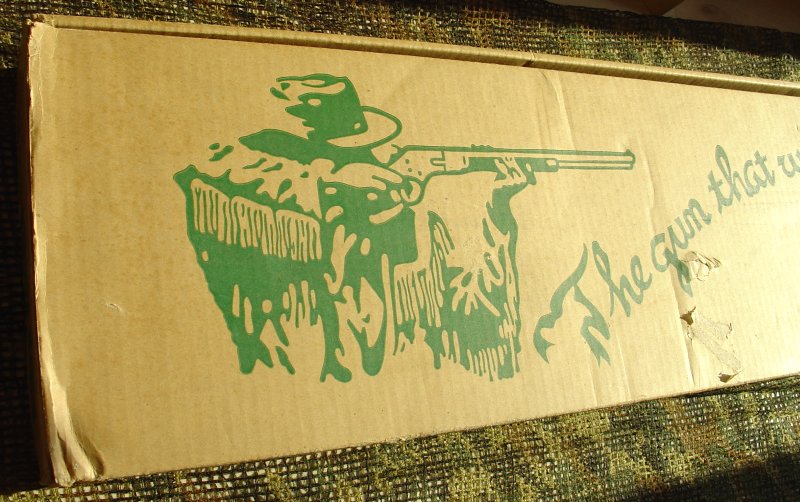
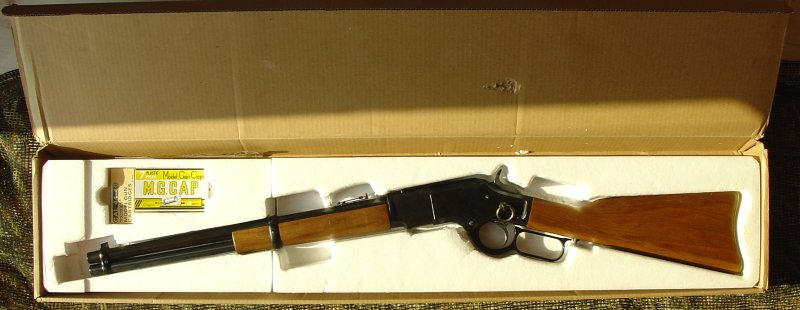
Inside the box there is a styrofoam insert with holes cut for rifle, box of cartridges and box of caps. There should also be a printed manual. I thought mine came without it, fortunately I checked under styrofoam ;-) Manual features picture guide for using and disassembling this modelgun. There are also troubleshooting pictures, showing how to clear stuck cartridge using a screwdriver.

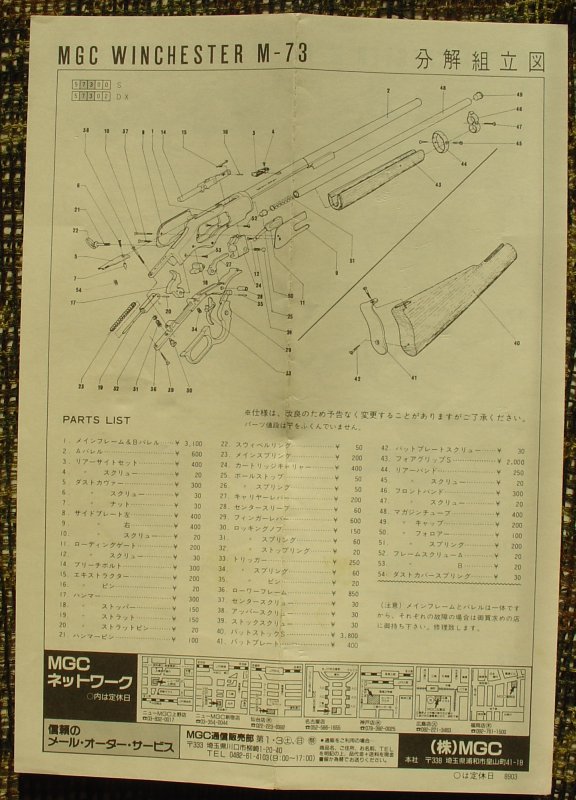


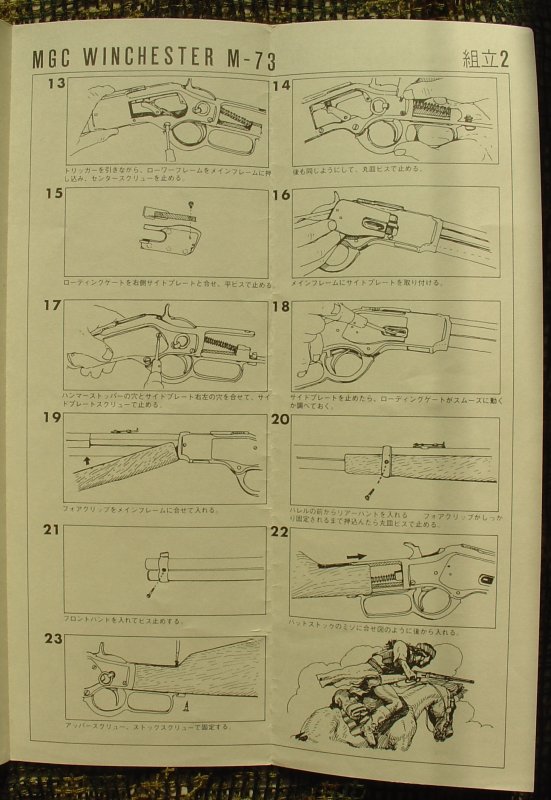 Modelgun
ModelgunIt's a rifle! Looks smaller than I expected, until you realize this can't be same size as a musket or a long rifle because it was often used while riding on horse.

There is a barrel, with a second tube - magazine - running just underneath. They are held together by a metal bracket with a simple front sight at the top. Near middle of the rifle there is a wooden foregrip, held in place by another bracket.


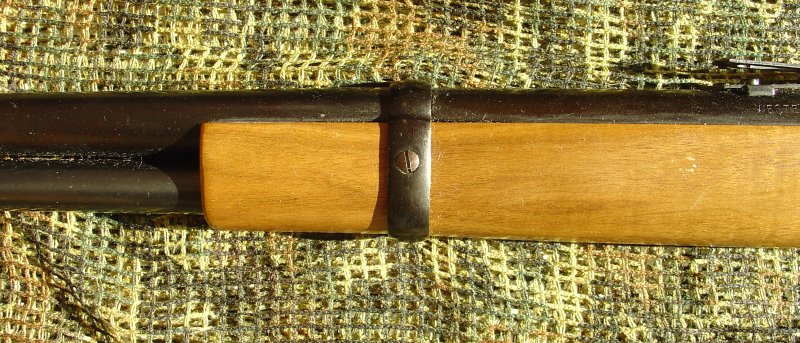
Rear flip-up sight is screwed on top of the barrel, near end of foregrip. Sight is very flimsy, made of thin sheet of metal, with a slider to select range. I've never seen cowboys flipping the sight up, even when sniping - they either shoot rifle from a hip or use fixed V-shaped tab at the end of the sight. Sight is not really held down, or up, except by friction at the hinge. As far as I can say this replicates accurately real rear sight.
Compared to sights of many other rifles this one is a disappointment (for a rifle, not modelgun).



Right below rear sight you will find all markings seen on this rifle. Left side states simply "WESTERN SADDLE CARBINE", the other has SMG stamp (Safe Metal Gun) and date of production. Mine is "05 * 92", so it's celebrating its eighteen birthday

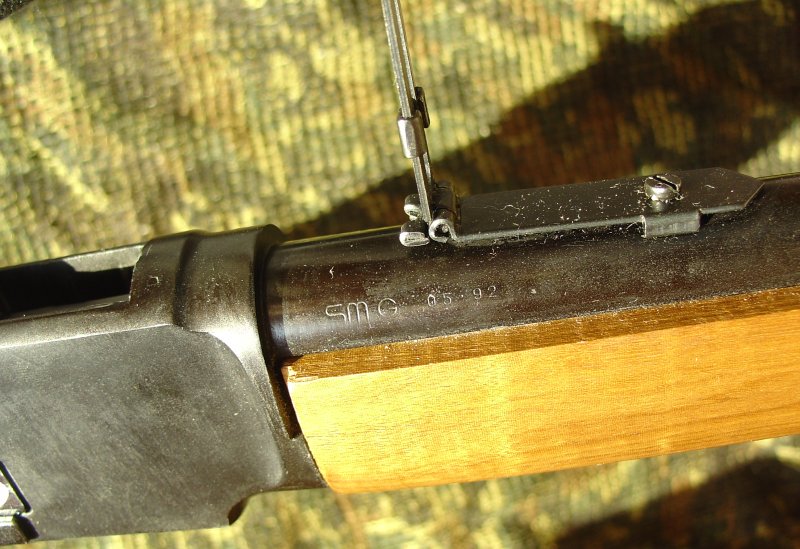
Back end of the gun features a wooden butstock with a yellow-coloured metal buttplate held by two screws. Wood finish quality is somewhere in the middle of the scale. It does not look like plastic, nor like wood used in CMC Mauser 98k. Not bad, yet not something I could rave about.


Just in front of the stock, on the left, a large and solid metal ring is attached to the rifle. For a long time I thought it was used to hang the rifle on the saddle - making it a "saddle rifle". It is actually used to keep the rifle attached to the rider (using a sling), so if he falls off the horse the rifle stays with him.
Now to the main part, where the action happens. At the top you will find a sliding cover that covers ejection port to protect it from the dirt when rifle is transported. Cover automatically opens when rifle is cocked, and stays open. You can close it manually, but there is no need to open it manually.


Hammer is located at the back of the rifle, above the stock. It is cocked by moving bolt, and stays latched in the back position until released using trigger. You can cock trigger manually, if needed. You can also decock rifle by holding hammer, pulling trigger and slowly releasing hammer to the forward position.

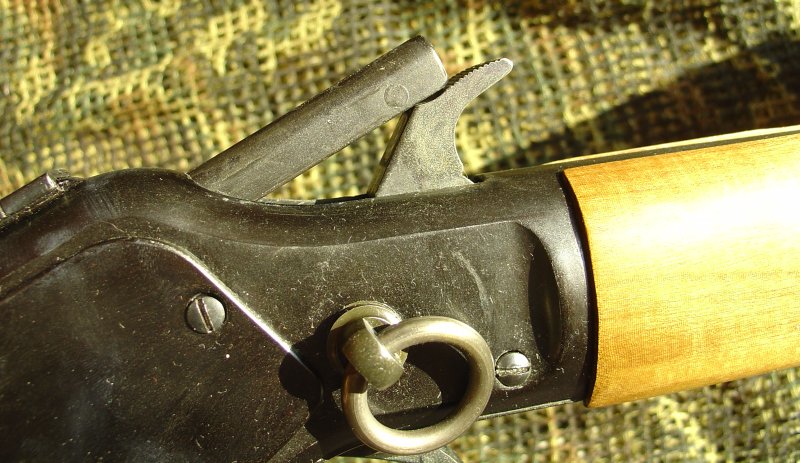
Right side features a silver loading gate, where you insert cartridges to the magazine.


Underside of this rifle features two very important pieces: trigger and lever.
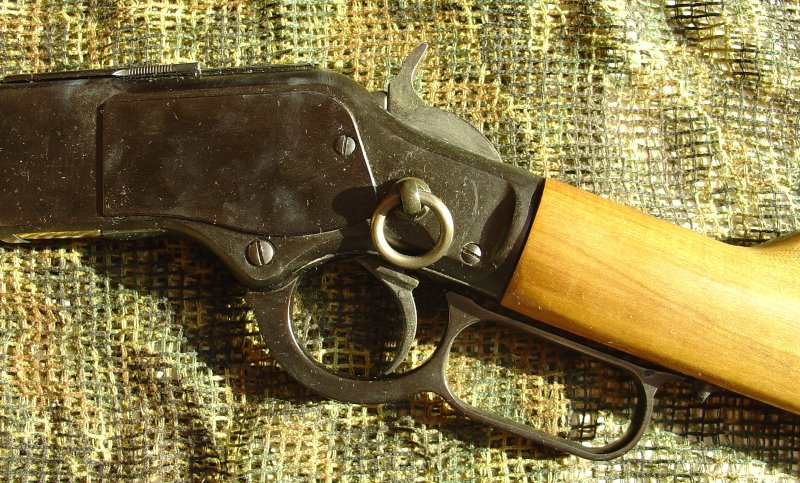

Trigger has a long pull that gets much heavier near the end. This is far from usual modelgun characteristic, more similar to dummy Kokusai P-38 that I described elsewhere. I also found that trigger has more than one "released" position, sometimes you can see trigger spring poking out a bit.
Trigger guard is actually a lever, with a large loop attached behind trigger. When you hold rifle for shooting you normally have your strong hand on the stock, index finger on trigger. Here you insert the rest of fingers through the loop, holding them to the stock in normal position. If you do not hold lever, it will dangle loose under the rifle.
You push that lever down, then back up to load the first cartridge, reload after a shot, or to unload cartridges without firing.
When lever is pushed down, it performs two actions. Bolt is moved backwards, extracting (and ejecting) cartridge from the chamber and cocking hammer at the same time. Cartridge carrier is also moved downwards and the first cartridge pushedby spring slides out from magazine into the carrier. Carrier is a sort of elevator for transporting cartridges from magazine to chamber, it is silver and you can see it moving from the top, as well as from the bottom.
During upward movement carrier goes up, positioning a cartridge in front of the bolt, then bolt moves forward pushing cartridge from carrier inside the chamber.







This Winchester model features a simple safety in form of a small button near back of the lever. Button can be turned so it prevents blocks lever (can't load/reload), but not trigger (you can fire if cocked).
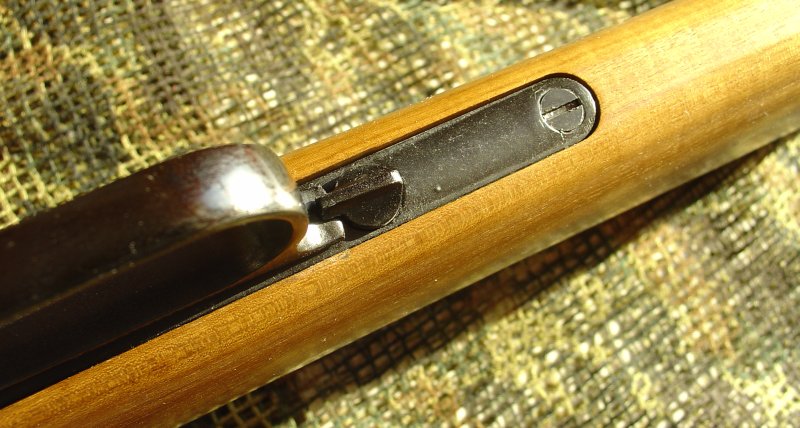
 Magazine
MagazineUhm... there is no detachable magazine. Winchester 1873 model uses a tube magazine that is permanently installed under the barrel. Capacity in such rifles depends on length of the tube, cartridge length and spring length. MGC model seems to have enogh space for 11+1+1 cartridges (tube + carrier + chamber).
"Octagon" version has a longer barrel, longer tube and larger capacity (one or two more cartridges, I think), while "Randall" is obviously shorter, probably half the capacity of larger brothers.
If you want to emtpy magazine without shooting, just move the lever down/up ejecting (upwards) all cartridges from the rifle until it is empty. Remember to ensure chamber is empty, too. Release slowly hammer, do not let it slam unnecessarily.
CartridgesOriginal cartridge is a very simple, open type. It is solid brass, with rim and hole in the tip where you insert a single 7mm cap. To extract cap after firing you need to use a needle, small screwdriver, or included metal pointed rod to pluck out the cap from the cartridge.
Simple design meanst that these are very easy to use and take care of :-)
Later MGC introduced a modified two-part version of the cartridge. Main part was now hollow, with a cylindrical insert inside. The goal of modification was to make extracting spent cap easier. Insert could be pushed from the bottom to get rid of a cap. This new design also has a groove around the cartridge, probably simulating a bullet.
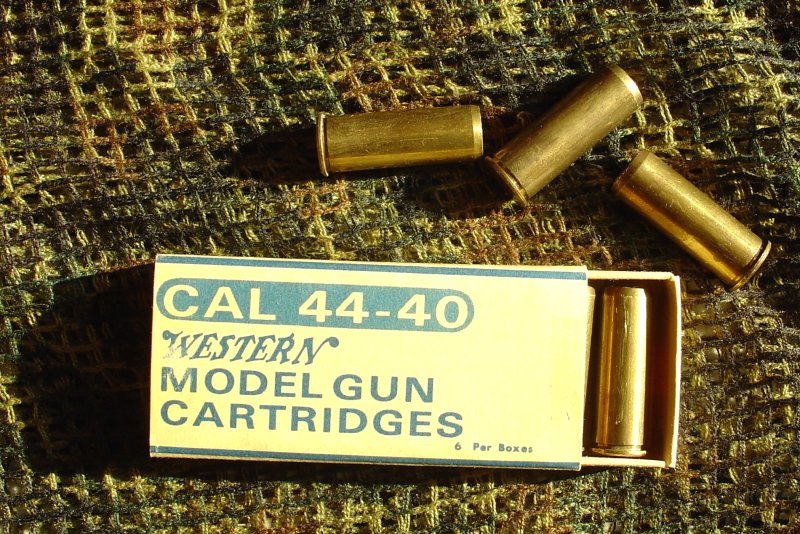




 Firing
FiringRifles have a huge advantage over pistols and submachine guns: blowback is not required for a correct operation :-)
Before shooting load cartridges - just push 7mm caps onto their tops. Load cartridges into the rifle - there is a port on the right side, below chamber, closed by a swinging gate. Front side of the gate can be pushed inside and cartridges inserted into the opening. Repeat process, taking care because when spring gets tighter it will attempt to eject cartridge that you try to put inside!
After loading magazine, switch off "safety" to be able to move the lever. Crank lever down and back up in a quick motion. This will load a cartridge into the chamber and open ejection port at the top of the rifle.
Target, pull trigger... BANG!
Move lever down/up, pull trigger again and have fun :-DDD
Cartridges are heavy, and ejected upwards, so take care to avoid dings in your walls, or broken items ;-)
Smoke and sparks will go out from the area near chamber because this is a closed barrel variant. In open barrel version you should get interesting effects from the front, as all cap power is directed into it instead of blowback action.
Blockages do not happen frequently due to lack of blowback. If mechanism locks somehow, it can be restored with just fingers.
Bit of disassemblyTo show how simple is the mechanism I removed two side plates that normally cover it.
Both left and right cover are held together by a single screw on the left side. Remove it, and covers will be removed (one at bottom will probably just fall out, surprising you.
Covers not only hide mechanism, but they also keep bolt in a correct position using parts protruding to the inside. When assembling back, hold bolt upwards so it does not interfere, this should get obvious when you actually do it. You can see at the picture that bolt tends to fall lower when lever is moved down.
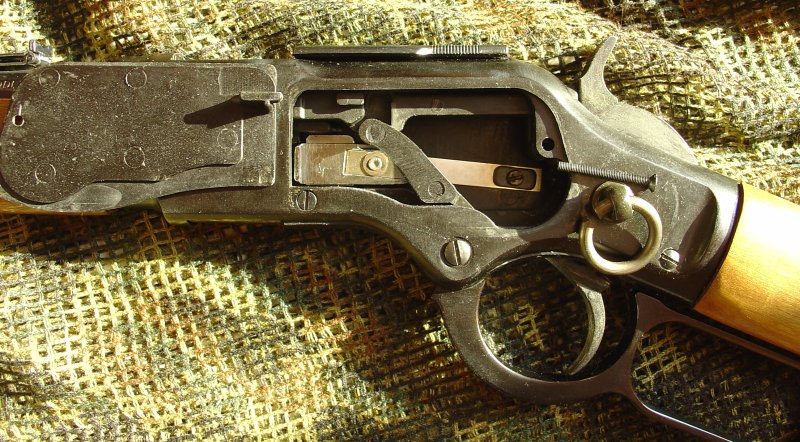

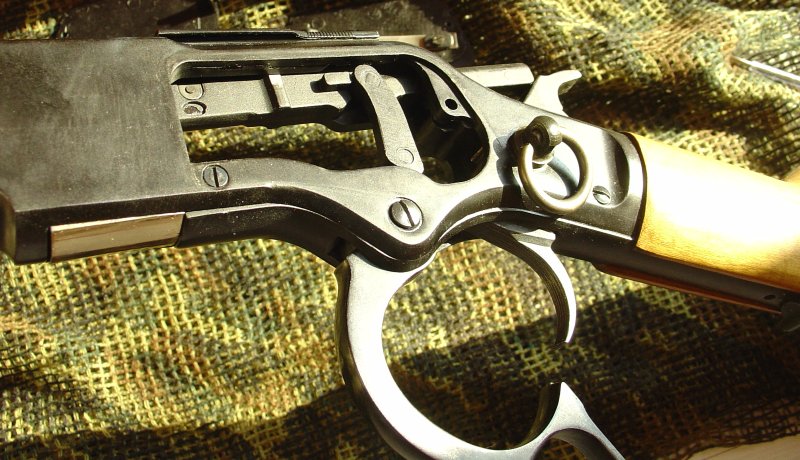


Further disassembly is clearly shown in the manual - you remove the buttstock, main lever hinge, all internals, .
ProblemsMGC Winchester M1873 is pretty reliable model, with solid construction, few moving parts and no blowback to complicate things. Most of the time it works without issues.
For completeness I have the following remarks:
OverallThis is a very nice rifle! Lever-action makes you feel like a western hero :-)
I like it a lot, as it is a nice change from the usual pistols where you just pull the trigger.
If you can, try to find open barrel version, or for best effect open barrel Randall. With very short barrel it produces much better effects. You might also want to look for version that has exotic wood stock for better looks.
